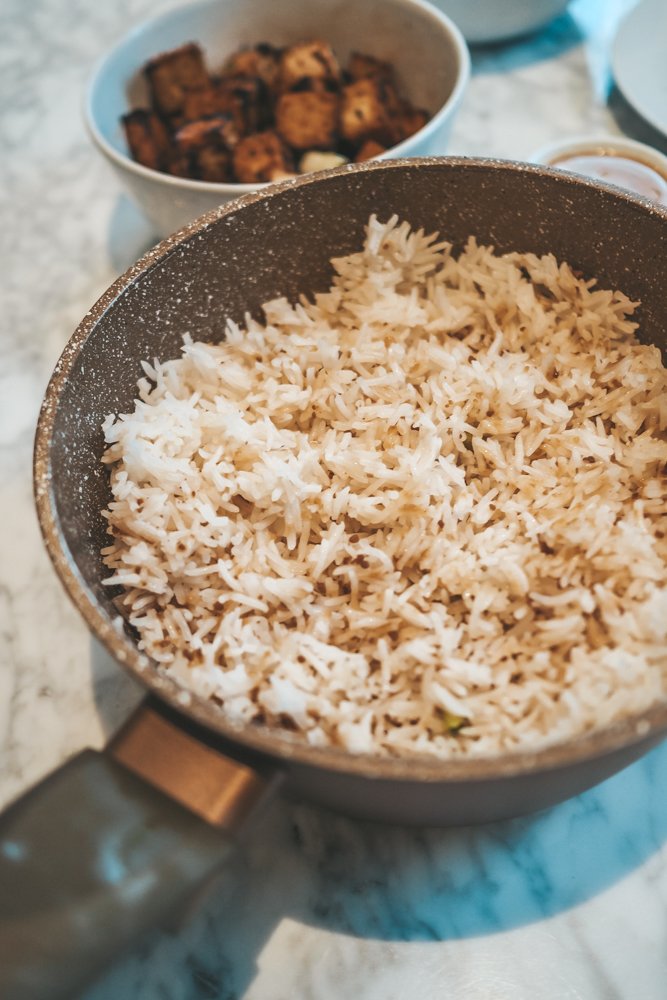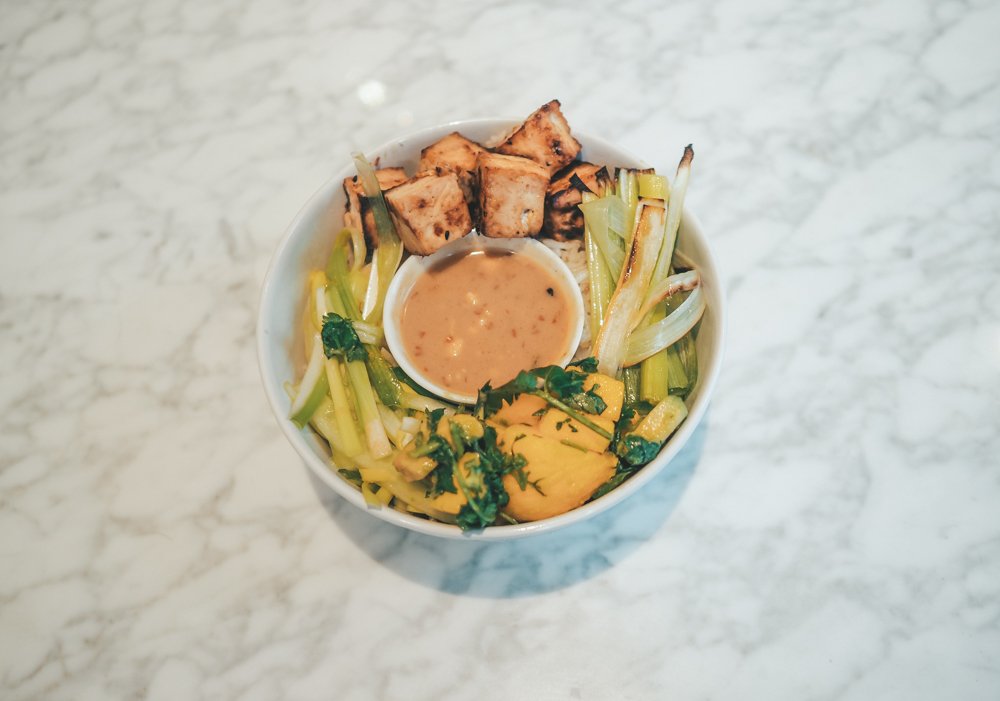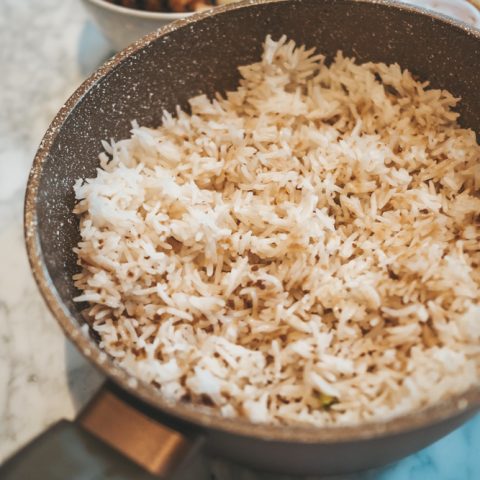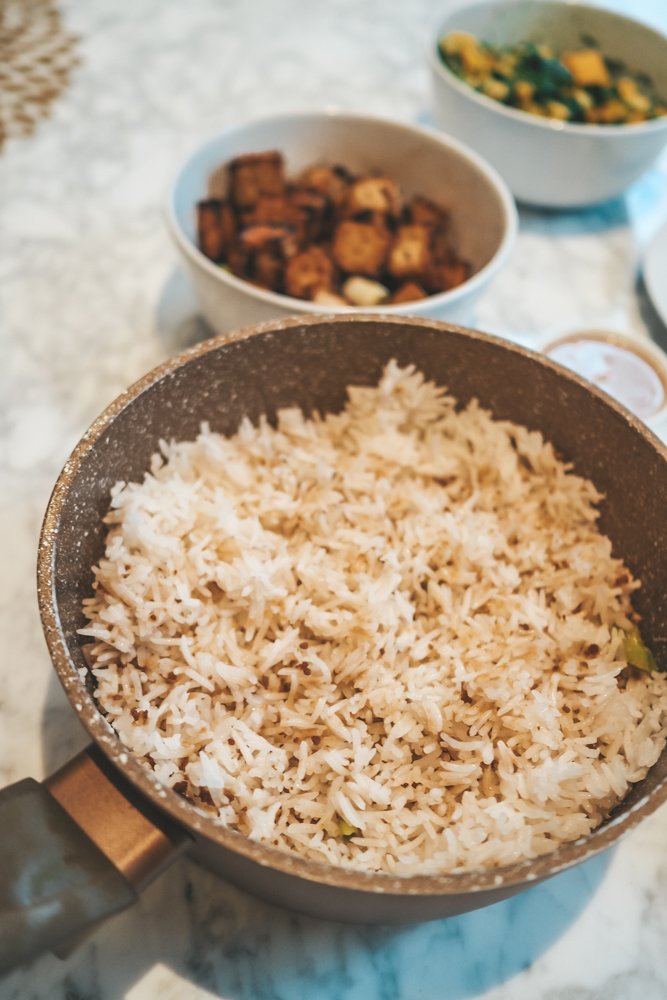In as much as plain rice can be boring and tasteless, this garlic basmati rice recipe is flavourful, rich and garlicky. Although basmati rice is distinctly Indian or Middle Eastern, this dish is wonderfully versatile for use across cuisines (be it Asian, South Asian, Middle Eastern or European cuisines) or for use in specific meals.
It takes me back to a breakfast dish we loved during our time on Boracay Island in the Philippines, an intensely tasty garlic rice dish I’ve tried to recreate since then and only recently got right. If done well, the rice is light and fluffy, the garlic flavour is pungent and powerful, and the spring onion is crunchy, fresh and bitter – a vegan dish that’s hard to beat! It’s also incredibly easy to make at home.
Garlic Basmati Rice

Serving Suggestions
Garlic basmati rice is tasty enough to be eaten alone, but best served with a variety of side salads or cooked elements. Simply combine with the following complementary dishes in the list below for a perfect, healthy yet filling vegan dish like our Tofu Poke Bowl.
Vegan Mango Salad
Roasted Leeks
Asian Garlic Tofu
Cucumber and Spring Onion Salad
Raw Vegan Satay Dressing

Ingredients
| Ingredients | Notes | Substitutions | |
| Basmati Rice | Basmati rice is a great base – it holds its shape well, it binds and still becomes fluffy, and is tried and tested as a biryani or other cooked rice preparation. Are you a serious rice enthusiast? Try an aged basmati from an Indian or Asian brand – it’s not to say that your supermarket brand of basmati rice will not be fine, but I figure that people whose native cuisines include basmati rice are the best judges of what separates a good rice from a great rice. | This can be changed out for jasmine rice or brown basmati rice, just be sure to consult the cooking suggestion for the appropriate amount of water. | |
| Garlic | The garlic fulfils two functions – giving the intense sweet alliaceous flavour to the cooking oil, as well as giving texture to the rice after it has been cooked. | You can use frozen garlic if you don’t have fresh garlic to hand. It works just as well, as the garlic will be cooked and most of the garlic flavour extracted into the cooking oil. Feeling adventurous? Try using something with a similar base flavour such as shallot or ginger. | |
| Rapeseed Oil | Rapeseed oil has a high smoke and neutral taste, so it is great for frying at high temperatures and infusing flavours into the oil to put into the dish later. | Replace this out with some other neutral and high smoke-point oil. Avoid olive oil, think vegetable oil or sunflower oil. | |
| Spring Onion | Spring onions give a fresh, alliaceous and herbaceous flavour to a dish and a bit of texture. It also adds lots of brightness to rich dishes. | To substitute the herbaceous/fresh flavours, try herbs like parsley or coriander. To substitute the alliaceous flavour, try finely chopped raw red onion or (if in season) wild garlic. | |
| Salt | Salt tends to heighten the natural flavours of dishes as well as the salt content of the dish itself. The amount of salt you introduce to a dish can affect the cooking and preparation , so it is important to consider at what stage one seasons the dish. Conventional wisdom is to season as you go and taste your food along the way. | By replacing sea salt or plain salt, you can also introduce other flavour elements into a dish which can have remarkable benefits (or indeed throw your recipe into disarray!). Soy sauce or tamari (gluten-free soy sauce) can give a salty and umami flavour, whilst some pickles (for example, Japanese umeboshi – pickled or brined plum) can be intensely salty and introduce another sour flavour element. | |
| Water | If possible use filtered or bottled water. Tap is normally fine (depending on whether it is advisable to drink tap water in the location you are cooking), but it is desirable to have consistent results. Having water which is filtered to the same level helps to give more consistent, replicable results rather than tap which can vary from day to day. |
Instructions
- Pour the two cups of rice into a fine mesh sieve and run under cold water to remove any dust, excess starch or other particles from the industrial process to prepare the rice. Run your fingers through the rice to ensure that the water reaches all or most grains of rice. Do this until the water runs clear rather than milky (about 5 minutes or less). Set aside for later use. NB: it is suggested in some traditional recipes that after this stage, you soak the rice in salty water for two hours before use. Whilst the step is useful to ensure that the dish is well seasoned and the rice is cooked correctly, on balance I’ve found that you can get away with not soaking the rice.
- Heat up the rapeseed oil in a pot or saucepan over medium flame. When the oil shimmers, introduce the minced garlic with a pinch of salt and cook out the garlic until the garlic is golden in colour – be careful not to go too far beyond this stage as burnt garlic will make the oil taste bitter. This should take 5 minutes or less. When the garlic is cooked, strain out the cooked garlic (it should be crunchy or crispy, sweet but not bitter) and set aside for later use, and put the oil back into the pot.
- Bring the oil back to medium heat and introduce the rice. This is similar to a technique used in cooking Italian risottos and has a twofold purpose – 1) to help toast the grains of rice and cook out some of the raw flavour and give some addition flavour through the toasting, and 2) to coat the grains of rice in the flavoured oil and thereby introduce more flavour. Do this until there is no oil left at the bottom of the pot (again 5 minutes or less).
- Now introduce the cold water to the pot and a heavy pinch of salt. The technique does not call for boiling the rice, but steaming the rice, so the ratio of rice to water is important. The recipe is not a simple straight ratio either – generally the ratio calls for 1 cup of rice to 1.5 or so cups of water plus an additional ½ cup of water to allow for evaporation, although this depends on the type of rice. Bring the cold water to a boil over medium heat and turn down to a low heat for a bare simmer and cover the pot with a lid. This should take about 5 minutes to bring to the boil and a further 10 minutes until all the water has evaporated. When the water has evaporated, turn off the hear and set aside the rice for a further 10 minutes to allow the rice to steam.
- When the rice has steamed and the water evaporated, using a fork, fluff up the rice. Add in the reserved golden garlic pieces and the chopped spring onion, salt to taste and lightly mix (be careful not to break the grains of cooked rice). The rice is now ready to be served!
Recipe Card

Garlic Basmati Rice
A vegan garlic-infused basmati rice garnished with fried garlic and spring onion.
Ingredients
- 2 cups basmati rice
- 6 cloves minced garlic
- ¼ cup rapeseed oil
- 2 heavy pinches salt
- 2 stalks spring onion
- 3½ cups water
Instructions
- Place basmati rice in mesh sieve and run under cold water until water runs clear. Run your fingers through the rice to ensure that the water reaches all or most grains of rice.
- Heat rapeseed oil over a medium flame. Add minced garlic and pinch of salt and fry until golden - be careful not to go too far beyond this stage as burnt garlic will make the oil taste bitter. Carefully spoon out the fried garlic, leaving the oil in the pot.
- Bring the oil back to medium heat and introduce the basmati rice. Stir to coat the rice until all the oil is absorbed and there is none left at the bottom of the pot.
- Add the cold water to the pot of rice that has just been coated in oil, along with a heavy pinch of salt. Bring the water to a boil over a medium heat, then turn down to a low heat for a bare simmer and cover the pot with a lid. When the water has evaporated, turn off the heat and set aside the rice for a further 10 minutes to allow the rice to steam.
- When the rice has steamed, use a fork to fluff up the rice. Add in the reserved golden garlic pieces and the chopped spring onion, and salt to taste. Lightly mix everything together, taking care not to break the grains of cooked rice.
- Serve and enjoy as a dish on its own, as part of a lunch bowl or as a complementary side dish!
Recommended Products
As an Amazon Associate and member of other affiliate programs, I earn from qualifying purchases.
If you make this vegan garlic basmati rice dish, be sure to rate this recipe and let us know your feedback!
Don’t forget to pin this article if you found it helpful and follow Dukes Avenue on Pinterest for more!

Sarah is a syndicated freelance writer and editor of Dukes Avenue. She founded Dukes Avenue in 2018 as a creative outlet while working at a London hedge fund. What initially started as a small blog has become a widely read luxury lifestyle online publication targeted at the modern woman, with content curated to inspire readers to live their best and most fulfilled lives. Sarah has lived in London, Malta, and, most recently, the United Arab Emirates and uses her travels and experiences to inspire much of the content.
-
Sarah Borg Barthethttps://dukesavenue.com/author/sarah-borg-barthet/
-
Sarah Borg Barthethttps://dukesavenue.com/author/sarah-borg-barthet/
-
Sarah Borg Barthethttps://dukesavenue.com/author/sarah-borg-barthet/
-
Sarah Borg Barthethttps://dukesavenue.com/author/sarah-borg-barthet/







